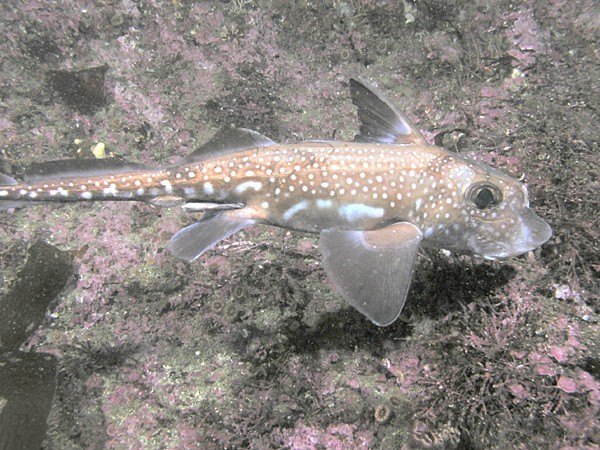Spotted ratfish
A species of Pale ghost shark, Also known as Elephant fish, Ratfish, Whitespotted ratfish Scientific name : Hydrolagus colliei Genus : Pale ghost shark
Spotted ratfish, A species of Pale ghost shark
Also known as:
Elephant fish, Ratfish, Whitespotted ratfish
Botanical name: Hydrolagus colliei
Genus: Pale ghost shark
Content
Description People often ask
 Photo By Clark Anderson/Aquaimages , used under CC-BY-SA-2.5 /Cropped and compressed from original
Photo By Clark Anderson/Aquaimages , used under CC-BY-SA-2.5 /Cropped and compressed from original Description
The spotted ratfish has a very distinct appearance compared to unrelated fish species. The female is up to 97 cm (38 in) long, much bigger than the male. These fish have a smooth and scaleless skin that is a silvery-bronze color, often with sparkling shades of gold, blue, and green. The speckled white spots along their backs contribute to their name. Dark edges outline both the caudal and dorsal fins, whereas the pectoral fins have a transparent outline. Their pectoral fins are large and triangular, and extend straight out from the sides of their bodies like airplane wings. They have a venomous spine located at the leading edge of their dorsal fin, which is used in defense. It does not present a serious danger to humans, but can cause painful wounds and has been known to kill harbor seals that ate spotted ratfish (caused by the spine penetrating vital tissue in the stomach or esophagus after the ratfish was swallowed). The tail of the ratfish constitutes almost half of its overall length and closely resembles a pointed, rat-like tail. The body of this fish is supported by cartilage rather than bone. It has a duckbill-shaped snout and a rabbit-like face. The mouth is small and contains one pair of forward-directed, incisor-shaped teeth in the bottom jaw and two pairs in the top jaw. Unlike sharks, which have sharp teeth that are easily replaceable, spotted ratfish teeth are plate-shaped, mineralized, and permanent, which assist them in grinding their prey. Like many bony fishes, but unlike its sister group, the Elasmobranchii, the upper jaw of the chimaera is fused with the skull. Although their jaws are soft and mouths are relatively small, they have the largest biting force and jaw leverage found within the Holocephali, which supports their ability to consume large prey. One of their most mesmerizing features is their large, emerald green eyes, which are able to reflect light, similar to the eyes of a cat.
* Disclaimer: The judgment on toxicity and danger is for reference only. We DO NOT GUARANTEE any accuracy of such judgment. Therefore, you SHALL NOT rely on such judgment. It is IMPORTANT TO SEEK PROFESSIONAL ADVICE in advance when necessary.
People often ask
How big does spotted ratfish get?
Is spotted ratfish dangerous to humans?
What does spotted ratfish eat?
What eats a spotted ratfish?
Scientific Classification
Phylum
Chordates Class
Chimaeras Order
Chimaera Family
Shortnose chimaeras Genus
Pale ghost shark Species
Spotted ratfish